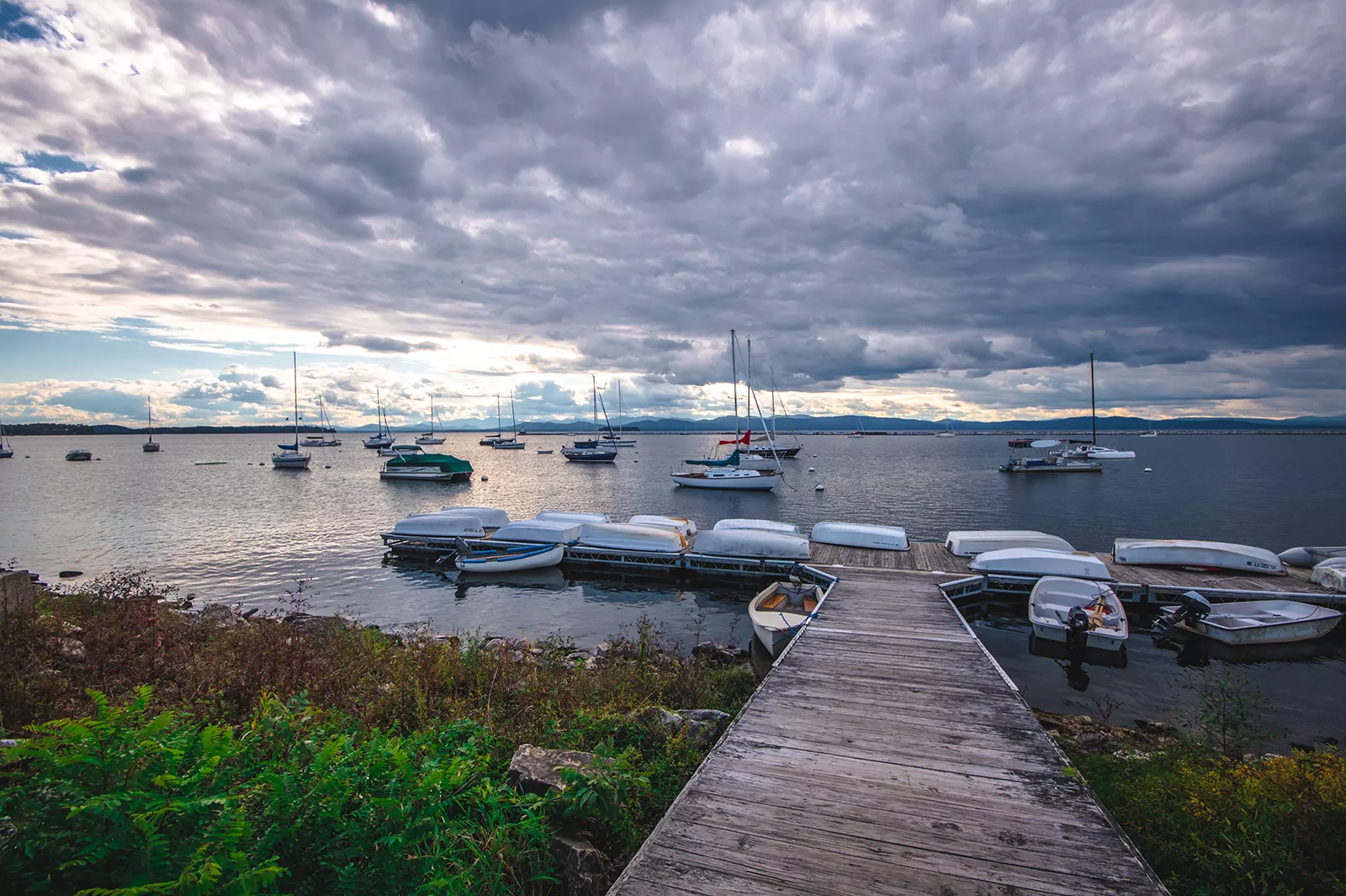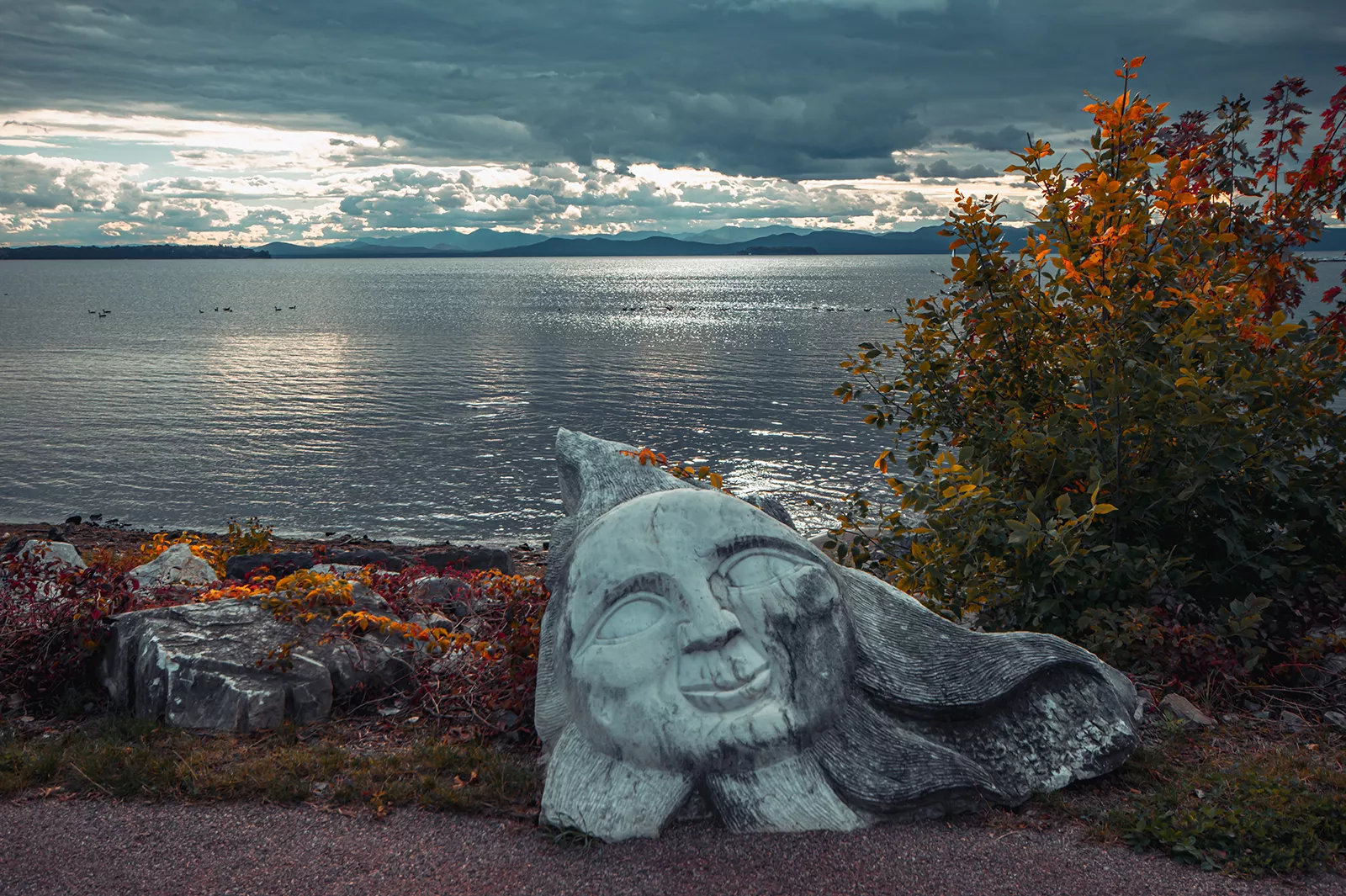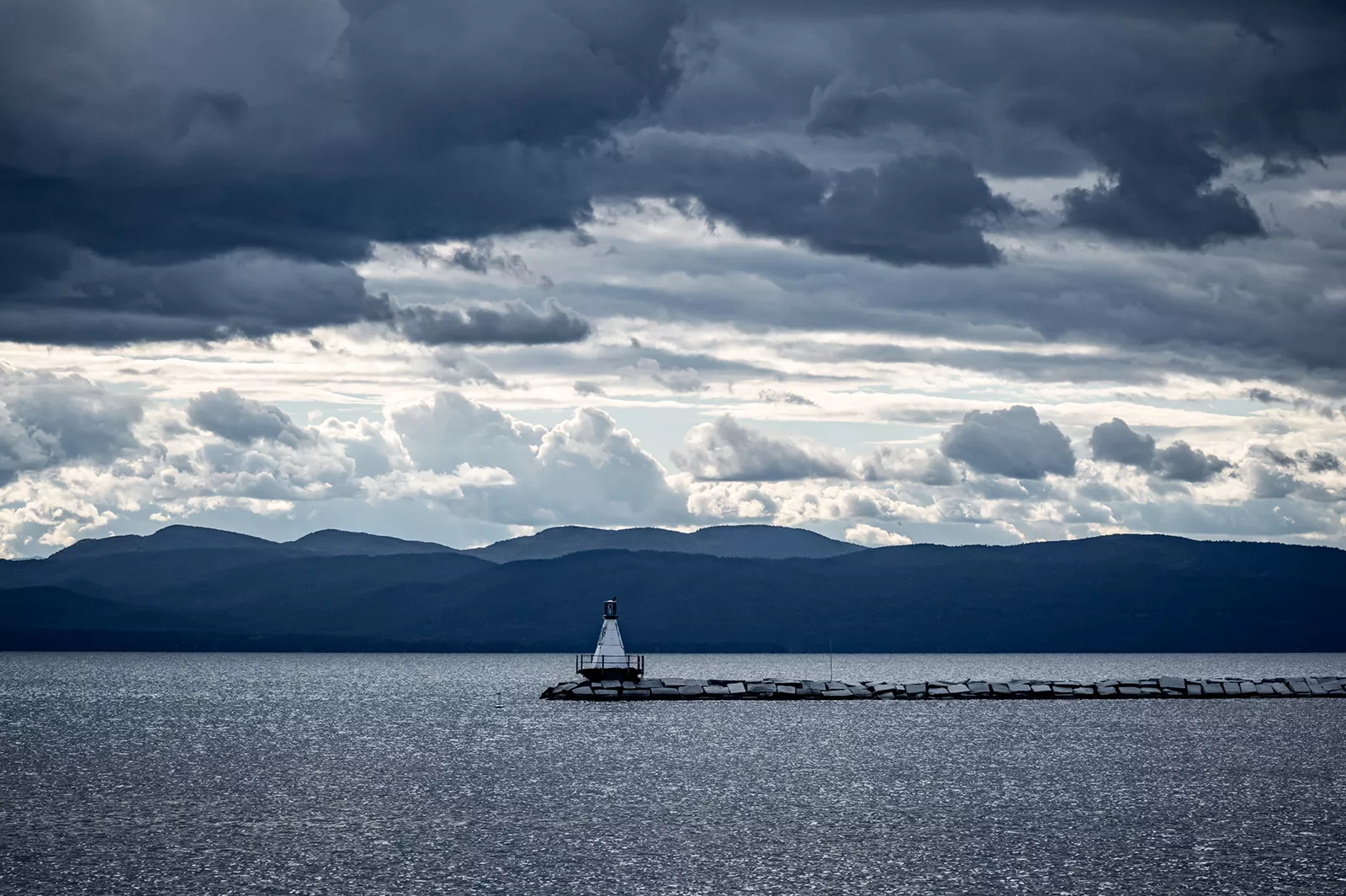Lake Champlain: A Tapestry of Nature, History, and Legend
Lake Champlain, spanning an impressive 172 kilometers, is a breathtaking body of water that connects various regions in the United States and Canada. It serves as a vital link between the Hudson River in New York, Montreal, and Vermont, before flowing into the Richelieu River and eventually joining the mighty St. Lawrence River. Nestled within a scenic valley, Lake Champlain receives its water from the surrounding mountain ranges, creating a picturesque landscape that enchants visitors and locals alike.
Lake Champlain offers a tranquil escape with breathtaking views, untouched by bustling development. Engage in various activities or simply unwind in serene bliss.
One of the notable characteristics of Lake Champlain is its narrow width, with the widest point measuring only 12 miles. Despite its narrowness, the lake boasts impressive dimensions. It is the sixth-largest body of water in the United States and is situated at the lowest point in the region, approximately 100 meters above sea level. In 1998, former President Bill Clinton quietly declared Lake Champlain as one of the Great Lakes in America. However, this decision faced criticism from many people who argued that the lake’s smaller size did not warrant such a designation. As a result, the title was swiftly revoked shortly after its initial declaration, preserving the distinction of the traditional Great Lakes. Nevertheless, the allure and significance of Lake Champlain remain unaffected by its classification, continuing to captivate visitors with its natural beauty, recreational opportunities, and rich history.
The History of Lake Champlain
The shores of Lake Champlain bear witness to the footsteps of early explorers who ventured into the unknown in search of new lands and trade routes. French explorer Samuel de Champlain, for whom the lake is named, first laid eyes on this breathtaking expanse of water in 1609. His exploration of the lake and surrounding areas established a foundation for the European presence in the region.
During the American Revolution, Lake Champlain became a vital theater of war. In 1776, the American naval fleet, commanded by Benedict Arnold, engaged the British fleet in a decisive naval battle known as the Battle of Valcour Island. Despite being outnumbered and outgunned, Arnold’s strategic maneuvers and valiant efforts delayed the British advance, giving the Americans crucial time to prepare for further confrontations. This battle marked a turning point in the war and solidified Lake Champlain’s place in American history.
The lake’s strategic significance continued in the War of 1812 when British forces sought to control the vital waterways of the Great Lakes and isolate the New England states from the rest of the United States. The Battle of Plattsburgh, fought on the shores of Lake Champlain in September 1814, proved to be a decisive victory for American forces. The American naval fleet, led by Commodore Thomas Macdonough, successfully defended Plattsburgh Bay against a British invasion force, forcing the British to retreat and effectively ending their campaign in the region.

Lake Champlain’s historical legacy extends beyond military conflicts. The region played a crucial role in the development of the United States as a young nation. The lake served as a vital transportation route during the era of steamboats and canal systems, facilitating trade and commerce between the northern states and the Hudson River Valley. The Champlain Canal, completed in 1823, connected Lake Champlain to the Hudson River, opening up a vital trade route that boosted economic development in the region.
The lake and its surrounding areas have been inhabited for thousands of years by Native American tribes, including the Abenaki and Mohawk nations. These indigenous communities relied on the lake’s bountiful resources for sustenance, transportation, and cultural practices, leaving their own indelible mark on the region’s history.
Lake Champlain’s historical significance extends beyond shipwrecks and exploration. In the 1900s, when maritime freight was a primary mode of commercial transport, the lake played a crucial role in facilitating trade and transportation. However, with the rise of truck transportation in the 1970s, its prominence in shipping gradually diminished. Despite this shift, Lake Champlain remains a vibrant waterway, serving as a means of transport for both locals and tourists.
What To Do When You Visit Lake Champlain
Lake Champlain offers a plethora of outdoor recreational activities, catering to enthusiasts of biking, hiking, and boating. The stunning natural landscape surrounding the lake provides the perfect backdrop for exploration and adventure.
For biking enthusiasts, the Lake Champlain Bikeway is a must-visit attraction. The bikeway encompasses a network of scenic routes that encircle the entire lake and extend along the Richelieu River in Quebec, Canada. The bikeway features a variety of paved rural roads, connecting theme loops ranging from 10 to 47 miles in length. Cyclists can traverse both paved and unpaved roads, immersing themselves in the breathtaking scenery of the Champlain Valley. Whether you’re a casual rider or a seasoned cyclist, the Lake Champlain Bikeway offers an unforgettable biking experience.

The Burlington Bike Path, located along the shores of Lake Champlain in Burlington, Vermont, is a popular destination for both locals and visitors. Stretching for 8 miles one-way (16 miles roundtrip), the bike path offers stunning views of the lake and the surrounding mountains. It is a favorite spot for cyclists, joggers, and walkers who want to soak in the beauty of Lake Champlain while enjoying a leisurely outdoor activity. The bike path provides easy access to several parks, beaches, and recreational areas, making it an ideal place to spend a day with family and friends.
Boating is another popular activity on Lake Champlain, thanks to its vast expanse of pristine water. Whether you prefer sailing, kayaking, canoeing, or motor boating, the lake offers something for everyone. Boaters can explore the countless bays, coves, and islands dotting the lake’s surface, discovering hidden beaches, secluded picnic spots, and peaceful anchorages. The lake’s calm waters provide the perfect setting for a leisurely day of boating, fishing, or simply enjoying the tranquility of the surroundings. Those without their own boats can rent kayaks, canoes, or motorboats from local outfitters, ensuring that everyone can experience the joy of being out on the water.
Hikers and nature lovers are also well catered to around Lake Champlain. The region boasts numerous hiking trails that wind through lush forests, meander along the lakeshore, and provide access to stunning viewpoints. Popular hiking destinations include Mount Philo State Park, offering a moderate hike with panoramic views of the lake and surrounding mountains, and the Ausable Marsh Wildlife Management Area, which provides opportunities for birdwatching and serene nature walks. The trails around Lake Champlain cater to all skill levels, ensuring that everyone can enjoy the beauty of the area at their own pace.

Fishing is a sought-after activity on Lake Champlain, attracting anglers in pursuit of various species. The lake is renowned for its abundant northern pike, bowfin, and large-mouth bass, making it a prime destination for fishing enthusiasts. In fact, Lake Champlain has consistently been ranked as one of the top five fishing lakes in North America, drawing anglers from far and wide to its bountiful waters.
When it comes to fish, Lake Champlain boasts an impressive variety of species. Anglers flock to its waters in pursuit of prized catches such as northern pike, bowfin, and large-mouth bass. The lake has gained recognition as one of the top five fishing lakes in North America, drawing fishing enthusiasts from far and wide. Additionally, other fish species like yellow perch, lake trout, and walleye can also be found in its depths, offering a diverse and exciting fishing experience.
The Ecological Importance of Lake Champlain
The lake and its surroundings have been recognized as an important ecological region. The water from Lake Champlain provides a source of fresh drinking water for approximately 250,000 people in various cities and towns. Efforts to protect and preserve the lake’s water quality and ecosystem are ongoing, with a focus on reducing pollution and promoting sustainable practices.
The lake’s shores and surrounding wetlands also provide crucial habitats for an abundance of bird species. Birdwatchers can delight in observing a wide range of avian residents and migratory visitors. Common loons, with their haunting calls, can be spotted gracefully swimming in the lake’s tranquil waters. Ospreys soar overhead, diving skillfully to catch fish with their impressive talons. Great blue herons wade in the shallows, while colorful warblers flit through the surrounding forests during the spring and summer months. Bald eagles, a symbol of strength and majesty, have also made a remarkable comeback in the region, their presence serving as a testament to successful conservation efforts.

On land, Lake Champlain and its surrounding areas provide habitat for various mammals. White-tailed deer, raccoons, and beavers are commonly found in the forests and wetlands along the shores. Red foxes dart through the underbrush, while the elusive bobcat silently prowls the wilderness. The lake also serves as a vital stopover point for migratory mammals, including bats, which find refuge in the surrounding forests and caves.
The flora surrounding Lake Champlain is equally diverse and captivating. The lake’s shoreline features a mix of sandy beaches, rocky cliffs, and marshy wetlands, each supporting unique plant communities. Tall, swaying cattails and vibrant water lilies adorn the edges of the lake, providing shelter for fish and other aquatic species. In the forests, towering sugar maple and yellow birch trees dominate the landscape, their vibrant foliage painting a stunning picture during the autumn months. Wildflowers, including trilliums and lady’s slippers, bloom in the understory, adding splashes of color to the forest floor.
Folklore of Lake Champlain
No discussion of Lake Champlain would be complete without mentioning Champ, the legendary lake monster that has captured the imaginations of locals and visitors for centuries. Champ, often referred to as the “Lake Champlain Monster,” is believed by some to be a surviving species of prehistoric creature or an undiscovered aquatic animal.
Tales of Champ date back to Native American tribes who inhabited the region long before European settlers arrived. The indigenous peoples spoke of a mysterious creature lurking in the depths of the lake, describing it as a large serpent-like creature with a humped back and a long neck.

As European settlers began to explore the lake in the 17th and 18th centuries, sightings of Champ became more frequent. Fishermen, sailors, and ordinary people claimed to have encountered a massive creature with a serpentine body, a horse-like head, and a pair of humps protruding from the water. Over the years, numerous eyewitness accounts and alleged photographs or video footage have further fueled the legend of Champ.
Intrigued by the reports, cryptozoologists and enthusiasts have dedicated themselves to investigating the existence of Champ. Expeditions have been launched, using sonar equipment and underwater cameras in an attempt to capture evidence of the elusive creature. While skeptics dismiss the sightings as misidentifications or hoaxes, believers in Champ continue to search for conclusive proof of its existence.
The legend of Champ has become deeply ingrained in the culture and tourism of the Lake Champlain region. The lake monster has become a beloved mascot and a source of pride for the local community. Visitors flock to the area, hoping to catch a glimpse of the elusive creature or to learn more about the fascinating folklore surrounding it.
Champ has also inspired various forms of artistic expression. The lake monster is depicted in local artwork, sculptures, and even on souvenirs, capturing the imagination of those who visit the region. The annual “Champ Day” celebration brings together locals and tourists for a day of festivities, including parades, games, and storytelling centered around the legendary creature.

Whether Champ is a mythical creature, a case of mistaken identity, or a genuine yet-to-be-discovered species, its presence in the folklore of Lake Champlain adds an air of mystery and excitement to the already captivating natural and historical wonders of the area. Visitors to Lake Champlain are encouraged to keep an eye out for any signs of Champ during their explorations, joining in the quest to unravel the secrets of this legendary creature.
With its rich history, stunning natural beauty, and abundance of recreational activities, Lake Champlain truly offers something for everyone. Whether you’re an outdoor enthusiast, a history buff, or simply seeking a peaceful retreat in nature, a visit to Lake Champlain is sure to leave you with lasting memories and a deep appreciation for the wonders of this magnificent lake.
What’s Nearby Lake Champlain
Lake Champlain is surrounded by a variety of captivating destinations and attractions, offering visitors a diverse range of experiences. Learn about the lake’s ecology and the regions natural history at ECHO, Leahy Center for Lake Champlain. Find a vibrant and bustling open-air market that showcases the region’s agricultural offerings at the Burlington Farmer’s Market. See a picturesque waterfall renowned for its natural beauty at Texas Falls Recreation Area. Hike along Thundering Brook Falls Trail and wind through lush forest to witness the impressive sight of the falls cascading down a rocky cliff. Explore the rich heritage of the War of 1812 when you visit the Battle of Plattsburgh Interpretive Center. Check out 2 forts, Fort St. Frederic and Fort Crown Point, at Crown Point State Historic Site.
These nearby locations offer a glimpse into the region’s natural beauty, cultural attractions, and recreational opportunities. Whether you’re interested in learning about the lake’s ecology, exploring vibrant markets, or immersing yourself in the wonders of nature, these destinations provide a fantastic complement to your Lake Champlain adventure.



